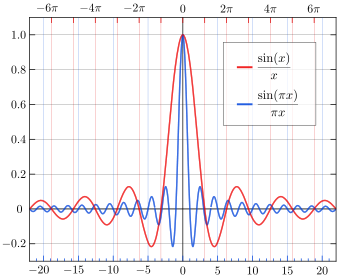Arg max

The unnormalised sinc function (red) has arg min of {−4.49, 4.49}, approximately, because it has 2 global minimum values of approximately −0.217 at x = ±4.49. However, the normalised sinc function (blue) has arg min of {−1.43, 1.43}, approximately, because their global minima occur at x = ±1.43, even though the minimum value is the same.[1]
In mathematics, the arguments of the maxima (abbreviated arg max or argmax) and arguments of the minima (abbreviated arg min or argmin) are the input points at which a function output value is maximized and minimized, respectively.[note 1] While the arguments are defined over the domain of a function, the output is part of its codomain.
Definition
Given an arbitrary set , a totally ordered set , and a function, , the over some subset of is defined by
If or is clear from the context, then is often left out, as in In other words, is the set of points for which attains the function's largest value (if it exists). may be the empty set, a singleton, or contain multiple elements.
In the fields of convex analysis and variational analysis, a slightly different definition is used in the special case where are the extended real numbers.[2] In this case, if is identically equal to on then (that is, ) and otherwise is defined as above, where in this case can also be written as:
where it is emphasized that this equality involving holds only when is not identically on .[2]
Arg min
The notion of (or ), which stands for argument of the minimum, is defined analogously. For instance,
are points for which attains its smallest value. It is the complementary operator of .
In the special case where are the extended real numbers, if is identically equal to on then (that is, ) and otherwise is defined as above and moreover, in this case (of not identically equal to ) it also satisfies:
Examples and properties
For example, if is then attains its maximum value of only at the point Thus
The operator is different from the operator. The operator, when given the same function, returns the maximum value of the function instead of the point or points that cause that function to reach that value; in other words
- is the element in
Like max may be the empty set (in which case the maximum is undefined) or a singleton, but unlike may not contain multiple elements:[note 2] for example, if is then but because the function attains the same value at every element of
Equivalently, if is the maximum of then the is the level set of the maximum:
We can rearrange to give the simple identity[note 3]
If the maximum is reached at a single point then this point is often referred to as the and is considered a point, not a set of points. So, for example,
(rather than the singleton set ), since the maximum value of is which occurs for [note 4] However, in case the maximum is reached at many points, needs to be considered a set of points.
For example
because the maximum value of is which occurs on this interval for or On the whole real line
- so an infinite set.
Functions need not in general attain a maximum value, and hence the is sometimes the empty set; for example, since is unbounded on the real line. As another example, although is bounded by However, by the extreme value theorem, a continuous real-valued function on a closed interval has a maximum, and thus a nonempty
See also
- Argument of a function
- Maxima and minima
- Mode (statistics)
- Mathematical optimization
- Kernel (linear algebra)
- Preimage
Notes
- ^ For clarity, we refer to the input (x) as points and the output (y) as values; compare critical point and critical value.
- ^ Due to the anti-symmetry of a function can have at most one maximal value.
- ^ This is an identity between sets, more particularly, between subsets of
- ^ Note that with equality if and only if
References
- ^ "The Unnormalized Sinc Function Archived 2017-02-15 at the Wayback Machine", University of Sydney
- ^ a b c Rockafellar & Wets 2009, pp. 1–37.
- Rockafellar, R. Tyrrell; Wets, Roger J.-B. (26 June 2009). Variational Analysis. Grundlehren der mathematischen Wissenschaften. Vol. 317. Berlin New York: Springer Science & Business Media. ISBN 9783642024313. OCLC 883392544.












![{\displaystyle Y=[-\infty ,\infty ]=\mathbb {R} \cup \{\pm \infty \}}](https://wikimedia.org/api/rest_v1/media/math/render/svg/d9c0eccb7aaa925b2aa6b9ae9473b3743f20cd08)






































![{\displaystyle {\underset {x\in [0,4\pi ]}{\operatorname {arg\,max} }}\,\cos(x)=\{0,2\pi ,4\pi \}}](https://wikimedia.org/api/rest_v1/media/math/render/svg/f8cc9d87b3c9d58f0f7223a632e5521facff5b34)













